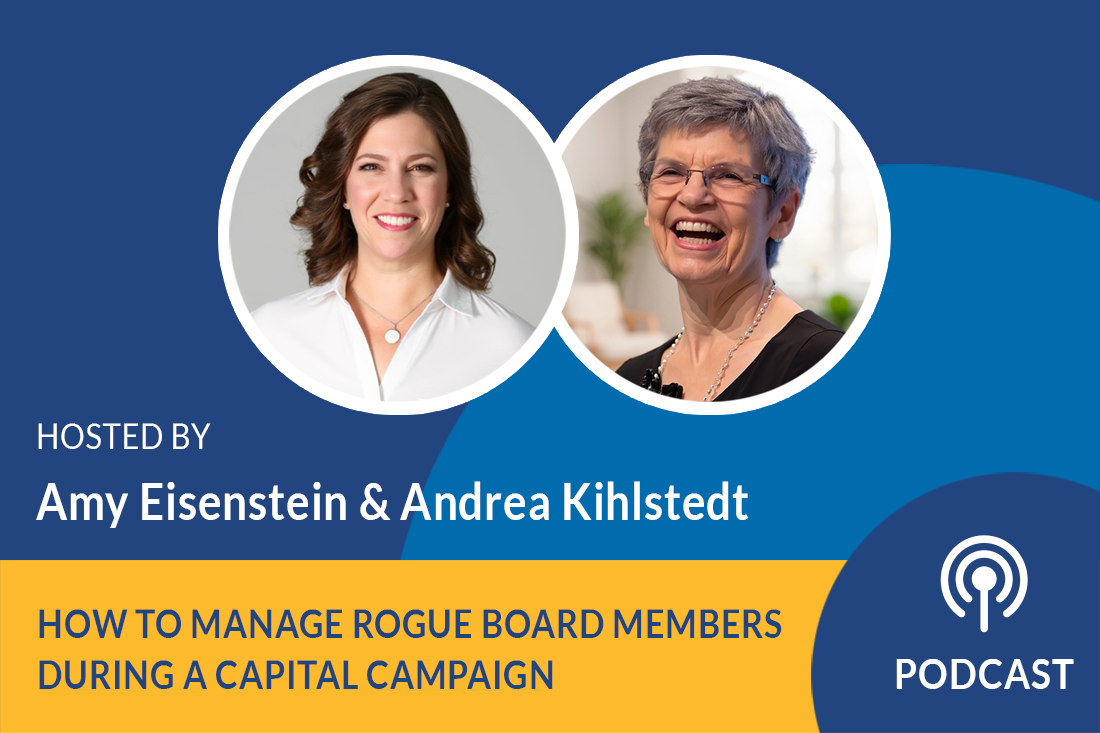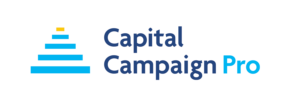Podcast: Avoid the Recession Mindset Trap When Considering a Campaign

Season 2, Episode 67
In this episode, campaign experts Amy Eisenstein and Andrea Kihlstedt discuss the perils of negative mindset and why they can stop you cold before you get going.
Listen Now:
Amy Eisenstein:
Are your board members nervous about considering a campaign and planning a campaign because the economy is so uncertain? Today, we’re going to give you three reasons that you should go right ahead with your campaign planning, no matter what’s happening in the economy.
Hello, I’m Amy Eisenstein. I’m here with my colleague, Andrea Kihlstedt, and today we are going to be talking about why you should continue planning your campaign no matter what’s going on in the outside world, in the economy, with politics, natural disaster. No matter what’s happening, you should proceed if you are ready to start planning a capital campaign. Andrea, what is the first reason that people should plow ahead with their campaign plans?
The Community You Serve is Depending On You
Andrea Kihlstedt:
Oh, Amy, I think the first and most important reason that people should plow ahead is because the people they serve continue to need them. Probably need them more in downtimes then in uptimes. And if what’s driving your campaign, and it’s what should be driving your campaign planning, is that people need you more and you need more facilities, or you need more program, or you need more funds to do whatever to boost your organization’s capacity. Well, you can’t just sit around and wait for that, right?
You’ve got to get going now because the people you serve need you.
Amy Eisenstein:
That’s right. Remember, campaigns take a couple of years, so whatever you’ve got planned, whatever your vision is, is not going to come to reality for a few years anyways. So the time to start is now. It’s really important not to put it off. And we see a perfect example of that with COVID, right?
When COVID started, things were very uncertain, and the organizations that were brave enough to continue with their campaign planning and execution through the beginning and middle of COVID, well, they’re finished with their campaigns and their projects are a reality now. And the organizations that hit the brakes at the beginning of COVID are either just starting or not even started yet.
Andrea Kihlstedt:
The other overlap with COVID, Amy, is that during COVID many organizations experienced a huge increase in need for their services. People were, and still are to some extent, in really dire straits.
So the organizations that were in the human services were pushed to the edge of what they could accomplish. And lo and behold, what they found is that because of COVID, because the need was so increased and donors knew it, people gave more money.
Amy Eisenstein:
That’s right.
Andrea Kihlstedt:
The downturn didn’t discourage people from giving. It actually motivated people to give, in part because everyone understood how much need there was and how much good organizations could do.
Amy Eisenstein:
Yeah, I think that’s such an important point. Because we make assumptions for our donors just because things are uncertain or rocky, that they’re going to shy away from things. But I think what we’ve seen time and time again is that when you communicate well, when you articulate the need, people come out of the woodwork and are generous in ways that you’d never expect.
So don’t make assumptions for your donors. Just because things are uncertain and you’re nervous, doesn’t mean that your donors won’t come through for you.
Capital Campaigns Take Time, And Time Heals Wounds
Andrea Kihlstedt:
Okay. Now, we promised you three points. That was the first point. Just to summarize, the first point is that your mission and the need for doing more for the people you serve should be primary in your planning. If your organization is gradually doing less, that’s another story. But I don’t expect that you are doing less or that your organization is doing less, right?
If you’re doing more and the need for your services is up, you should be planning a way to raise the money to support that kind of growth. That’s number one. Number two, what’s number two, Amy?
Amy Eisenstein:
Number two is that campaigns take a long time. They are multi-year endeavors, sometimes three, four, or even five years, and the economy fluctuates during that time. So just because it’s down when you’re getting started or you’re worried about a recession, by the time you get around to the quiet phase, the chances are very high that the economy will have rebounded. So let’s look a little more deeper into that.
Andrea Kihlstedt:
Amy, that’s funny. It’s kind of paradoxical because it also may be true that when the economy is high and the market is high, and then you say, well, now let’s start planning a campaign, that by the time you’re ready for the quiet phase, when you’re soliciting all your largest gifts, guess what? Your high economy is turned around. It’s starting on its way down.
Amy Eisenstein:
That’s right. The economy is cyclical. I mean, we know that. It fluctuates. It’s cyclical. And if your campaign, it takes two, three, four, five years, the chances are high that you’re going to see a wide variation in terms of what the economy’s going to do. It’s going to be up, it’s going to be down for part of your campaign. And unless you have a crystal ball, you cannot predict it. I mean, we predict that it will be up and down, and we’re going to be right.
Andrea Kihlstedt:
And we’re going to be right. For sure. I like being right, Amy.
Amy Eisenstein:
Yes. So just for a little history and a little detail, the economy does go up and down. And we took a close look at recessions in this country, and on average they last less than a year. In fact, in the last, I don’t remember what it was, 50 years, only one recession lasted more than a year, and it was a year and a half.
So I think a lot of your board members or your key leaders may think, oh my gosh, a recession is a horrible time for a campaign. But the reality is that your campaign’s going to span both good times and bad, and recessions historically don’t last. So no reason to put off your campaign just because the economy’s down at this particular moment. What’s point number three?
You Have to Be In It to Win It
Andrea Kihlstedt:
Point number three is this. Every campaign, when an organization thinks about starting a campaign, they always learn from a variety of sources that in their community there are many organizations planning or in campaigns.
- Your hospital is probably planning a campaign.
- The college in your community is planning a campaign.
- The homeless shelter is probably planning a campaign.
- The symphony orchestra’s planning a campaign, and there probably are two or three more.
So the field for capital campaigns is crowded. Except when times look bad, some board members of those organizations will say, no, no, we have to wait. And then some of those organizations are going to sit back, they’re going to get out of line. And if you are still in line, you move to the front of the line.
Amy Eisenstein:
That’s right.
Andrea Kihlstedt:
So don’t let yourself, don’t let your organization be the organization that is stepping back during these times while some smart organizations are continuing on. Stay in there, right? Put your shovel in the ground for the campaign and get going, and take advantage of the fact that some willy, no, what’s the weak livered? No, lily livered, what’s the expression?
Amy Eisenstein:
I don’t know.
Andrea Kihlstedt:
Weak willed organizations are going to be afraid and they’re going to stop their campaign planning.
Amy Eisenstein:
Yeah, I think —
Andrea Kihlstedt:
It hopefully works for you. It’ll work positively for you.
Amy Eisenstein:
That’s right. That’s right. I think bravery, accompanied by careful and thoughtful planning, does put organizations ahead. The reality is that there are always going to be people that are afraid. Some of your board members are going to be afraid. Your key leaders, some of them are going to be nervous.
Because campaigns by nature are scary. They are the biggest amount of money your organization has ever tried to raise. Often, double, triple, 10 times more than you’ve ever tried to raise. So that is nerve wracking. But there are plenty of ways to mitigate the risk.
And so regardless of what the economy’s doing, what the political climate is, what’s going on in the world, you can mitigate the risk with careful planning and hiring expertise and a good feasibility study so that you go in with your eyes wide open and the biggest chances for success.
You Can Only Control the Controllables
I’ll tell you one last thing. And that’s the other day my daughter and I were talking about things that she’s anxious about. And she said to me:
“Mom, all you can do is control the controllables.”
And I thought, that is exactly right. With a campaign, you can’t control the economy. You can’t control what other organizations are doing or what their campaigns are up to. You can’t control what’s going on, the outside forces. You can only control what you can control, and that is planning and executing a campaign with the best chances for success.
Andrea Kihlstedt:
Your daughter is very smart to know that at such a young age, Amy.
Amy Eisenstein:
Yeah.
Andrea Kihlstedt:
You must have done a good job in raising her.
Amy Eisenstein:
Well, thank you. Alright, so we’ve talked about three reasons that you should continue your campaign planning no matter what the outside forces are. If you have a big need and a big vision and big plans, continue with your campaign plans. And if you want help and expertise, do remember, we’re here to help.
So visit the Capital Campaign Pro website and sign up to talk to an expert. Sign up for a strategy session, and we would be happy to discuss your campaign and see if we can help you with your execution and planning and setting you up for the best chances for success. So thanks for joining us, and we’ll see you next time.



Leave a Comment